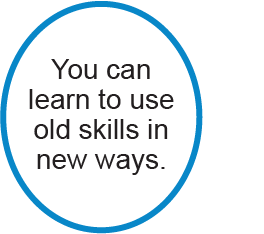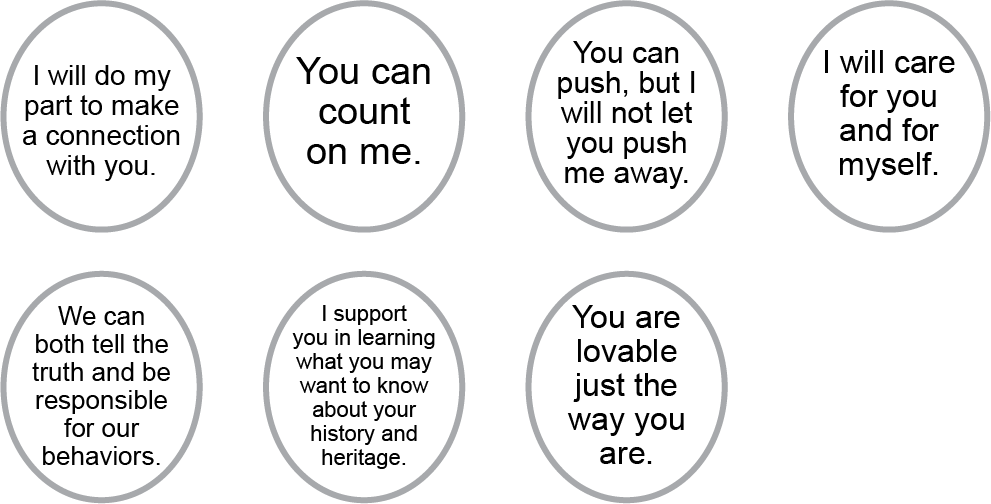14 How can professionals integrate Developmental Affirmations into their work?
In many different ways. The Developmental Affirmations can be integrated any time a professional in a helping field is teaching about development, parenting or personal growth. For instance, the affirmations can be embedded within a meeting or can be used at the opening and closing.

You can learn to use old skills in new ways.
Identity, Sexuality, and Separation — Stage 6
*
DIGGING DEEPER: examples.
As an opening, affirmations can raise the energy in the group, set a tone for growth and start everyone off with a positive message. An affirmation at the end of a meeting can provide closure, echo a topic of the meeting, express appreciation, or provide hope. You can write the Developmental Affirmations on your own cards, or print them out as a handout list or bookmarks. You can also purchase them as colored affirmation ovals cards.
Setting a positive tone for growth:
- Ayolanda spread the affirmation ovals word-side-up on a table. She posted a sign saying: “Please choose three affirmations that will help you get what you want from today’s meeting and ask two or three people to read the messages to you.” At the close of the meeting, she asked people to reread their affirmations and asked participants, “Did you get what you wanted? Raise a hand.” “Did you get more than you expected? Raise a hand.”
- Kim, who was leading a support group for dementia caregivers, started a meeting by giving everyone a copy of the Interdependence affirmation “Your love matures and expands,” and asked each person to find three additional affirmations that would support that message and to share them with a partner. At the close of the meeting, he asked the group to say, “Your love matures and expands” aloud in unison, thinking about themselves and then saying it again, beaming the message to the whole caregiver group.
Focusing the topic of the meeting:
- Leading a parenting group Ryan started the meeting with, “Choose three affirmations that could help your child become more competent. Tell your partner why you chose one of the affirmations.” At the end of the meeting, he asked people to reread the affirmations they chose at the beginning to see if they were still helpful. If someone needed a different one, he asked them to choose a new one and read it to their partner.
- Carrie, who was teaching the parenting program, The Developmental Parenting Highway, began the meeting with: “Look at the list of affirmations. Choose two that would help you be more confident at a moment when your parenting feels off track.” At the end of the meeting, she asked people to choose two affirmations that celebrate their ability to stay on track and keep their cars in the most helpful lane of the Parenting Highway, and to read the affirmations to the person next to them. This sends people out of the meeting with helpful words to hang on to. Click here for the online course.
Embedding
Affirmations may be embedded as an integral part of a program. For example, affirmations are a fundamental part of parenting education, “How Much is Too Much?,” “Growing up Again: Parenting Ourselves, Parenting Our Children,” and “How Much is Too Much, Leader’s Guide.” “How Much is Too Much?” is a research-based general parenting program that focuses on countering and reducing childhood overindulgence. Each of the six meetings includes information about the affirmations and an affirmation activity. The activities are designed to use the affirmations to support child development. They can also be used to support parenting strategies that help children learn that they are loveable, capable, and responsible to others in their homes and in their communities. “Growing Up Again” is a powerful general parent education program that helps parents get their developmental needs met while meeting the developmental needs of their children. It is also helpful for parents who want to parent differently than they were parented. In each of the six sessions, there are affirmation activities that support the growth of both parent and child.
Creating affirmations for specific needs
These affirmations can be a springboard for identifying affirmations for specific needs, such as adoption, foster care, stepchildren, disabilities, illness and recovery, or transitions. See how Connie Dawson adapted the developmental affirmations for adoption and foster care.



Feedback/Errata